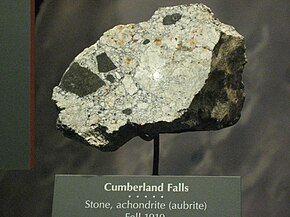| Achondrite | |
|---|---|
| — Type — | |
 Cumberland Falls, achondrite (aubrite) | |
| Compositional type | Stony |
 A eucrite achondrite from the Millbillillie meteorite shower. | |
An achondrite[1] is a stony meteorite that does not contain chondrules.[2][3] It consists of material similar to terrestrial basalts or plutonic rocks and has been differentiated and reprocessed to a lesser or greater degree due to melting and recrystallization on or within meteorite parent bodies.[4][5] As a result, achondrites have distinct textures and mineralogies indicative of igneous processes.[6]
Achondrites account for about 8% of meteorites overall, and the majority (about two-thirds) of them are HED meteorites, possibly originating from the crust of asteroid 4 Vesta. Other types include Martian, Lunar, and several types thought to originate from as-yet unidentified asteroids. These groups have been determined on the basis of e.g. the Fe/Mn chemical ratio and the 17O/18O oxygen isotope ratios, thought to be characteristic "fingerprints" for each parent body.[7]
- ^ Etymology: from the prefix a- (privative a) and the word chondrite.
- ^ Recommended classifications: Eucrite-pmict
- ^ Achondrite, Encyclopædia Britannica
- ^ Sahijpal, S.; Soni, P.; Gagan, G. (2007). "Numerical simulations of the differentiation of accreting planetesimals with 26Al and 60Fe as the heat sources". Meteoritics & Planetary Science. 42 (9): 1529–1548. Bibcode:2007M&PS...42.1529S. doi:10.1111/j.1945-5100.2007.tb00589.x.
- ^ Gupta, G.; Sahijpal, S. (2010). "Differentiation of Vesta and the parent bodies of other achondrites". J. Geophys. Res. Planets. 115 (E8). Bibcode:2010JGRE..115.8001G. doi:10.1029/2009JE003525. S2CID 129905814.
- ^ Mason, B. (1962). Meteorites. New York: John Wiley.
- ^ Mittlefehldt, David W.; McCoy, Timothy J.; Goodrich, Cyrena Anne; Kracher, Alfred (1998). "Non-chondritic Meteorites from Asteroidal Bodies". Reviews in Mineralogy and Geochemistry. 36 (1): 4.1–4.195.